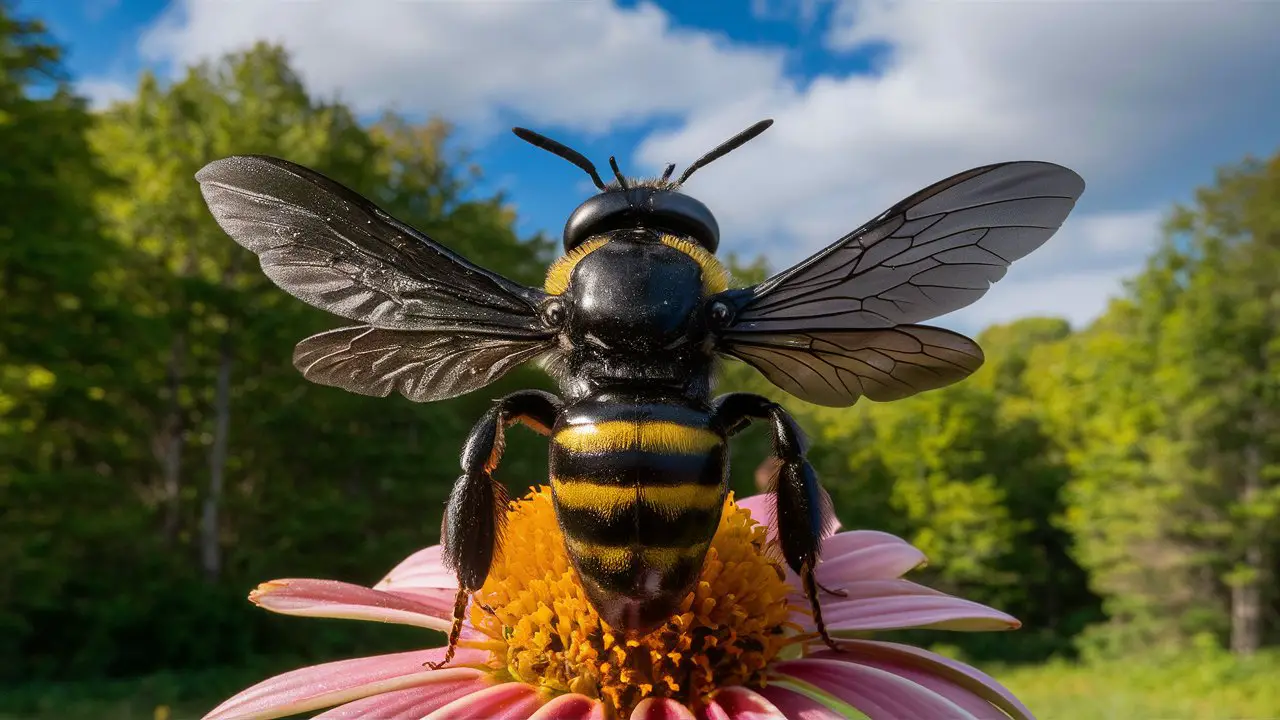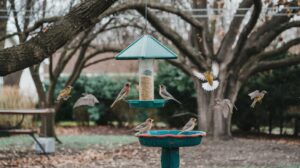As a homeowner, you know the frustration of those large, noisy carpenter bees that bore holes into the wood trim of your house. Their incessant buzzing and drilling damages your home’s appearance and structure. This year, resolve to keep these pests under control and protect your investment. In this article, you’ll discover the life cycle of carpenter bees, signs of an infestation, and time-tested methods to deter these insects. Arm yourself with knowledge and take proactive steps for effective carpenter bee control in 2024. Implement preventative measures early in the season and safeguard your home from damage. With persistence and the right techniques, you can enjoy your outdoor space free of carpenter bees.
Understanding Carpenter Bees: The Large Black Bee
Carpenter bees are solitary bees that resemble bumblebees. The most common species is the Eastern carpenter bee, Xylocopa virginica, a large black bee with a shiny abdomen. The male has a white spot on his face, while females have a black face.
Carpenter bees build nests by tunneling into wood, such as untreated wooden structures, fence posts, and utility poles. The female carpenter bee chews into wood to create a narrow tunnel as an entrance and a wider chamber inside to lay eggs. She then seals the entrance to the tunnel to protect the eggs as they develop into larvae and then pupae before emerging as adult bees.
Male carpenter bees are territorial and aggressive, often hovering in front of the nest entrance to guard the females inside. However, male bees lack a stinger and are harmless to humans. Female carpenter bees can sting but are not aggressive and will only do so in defense of their nest. Stings from females are painful but the venom is not lethal to most people.
Carpenter bee damage to wood can be prevented by painting or staining exposed wood surfaces, especially softer woods like redwood, cedar, cypress, and pine. Once carpenter bees have infested wood, the only way to eliminate the nest is to inject pesticide directly into the entrance hole or tunnel. Simply plugging the hole will not eliminate the nest and the bees will chew a new exit hole.
Overall, understanding the biology and behavior of carpenter bees can help in implementing effective control strategies to prevent damage from these wood-boring insects. With regular inspection and proper treatment of wood, carpenter bee populations can be managed and their destruction of property prevented.
Identifying Carpenter Bee Damage
Carpenter bees derive their name from their wood-boring behavior. They tunnel into wood to create nesting galleries for their young. If you notice quarter-inch holes in the wood of your home, especially in areas like eaves, siding, decks, and outdoor furniture, you likely have an active carpenter bee infestation.
You may also see coarse sawdust around the entrance holes or below the holes on the ground. Unlike termites, carpenter bees do not eat the wood. They excavate tunnels and chambers to lay eggs and store pollen. Nevertheless, their boring behavior can severely weaken wooden structures over time if left unaddressed.
Another telltale sign is seeing large black bees, about the size of a quarter, entering or hovering around the holes. The males are most commonly seen, as they establish and guard the territory around the nest. The females spend most of their time inside the nesting tunnels.
Rather than a continuous tunnel, carpenter bee nests contain a series of tunnels and chambers in a zig-zag or winding pattern. The female carpenter bee chews through the wood in a circular pattern to create each chamber, then seals off the chamber after laying an egg inside. She provides each larva enough pollen to sustain it through pupation.
An active infestation may contain up to 100 individual bees during peak activity in late spring and summer. If you notice carpenter bee damage, it is best to take action as soon as possible to avoid structural weakening and prevent the spread of the infestation. Several effective control methods, such as insecticidal sprays, wood treatments, and nest entrance barriers can be employed to eliminate carpenter bee nests and protect wood from further damage.
Preventing Carpenter Bees Without Killing Them
Carpenter bees are solitary bees that drill holes in wood to lay eggs and build nests. Although their drilling can damage wood structures, carpenter bees are important pollinators that should not be exterminated. There are several effective strategies you can employ to deter carpenter bees and prevent damage without killing them.
Seal Any Entry Points
The first step is to locate any existing holes or cracks leading into wood structures and seal them. Caulk, weatherstripping, wire mesh, or wood filler can be used to plug these openings. This will remove access to areas the bees have already started nesting in and prevent them from entering new sites.
Paint or Stain Exposed Wood
Carpenter bees are attracted to bare, unpainted wood. Staining or painting exposed wood surfaces, especially those most susceptible to drilling like eaves, siding, decks and railings, will make the area less suitable and appealing for nesting. Use a high-quality exterior primer followed by 2 coats of paint or stain for the best protection.
Install Motion-Activated Sprinklers
Motion-activated sprinklers, like those used to deter deer and other wildlife, can also be effective at repelling carpenter bees. The sudden burst of water startles the bees and conditions them to avoid the area. Place 2-3 sprinklers around the perimeter of your property, especially near wood structures. The sprinklers should be set to detect the slightest motion to activate when bees come near.
Provide Nesting Alternatives
Installing nesting blocks in a secluded area of your yard at least 15 to 30 feet away from wood structures will give carpenter bees suitable nesting spots as an alternative to drilling into your home or deck. The blocks should be untreated wood with pre-drilled holes of about 5 to 6 inches deep. This helps redirect the bees’ nesting behavior to more appropriate locations.
With patience and persistence, these humane deterrent techniques can re-train carpenter bees to avoid nesting in and damaging wood structures. By making your home less habitable and providing attractive alternatives, you can co-exist peacefully with these important pollinators.
DIY Carpenter Bee Traps and Baits
To control carpenter bee populations in a humane and environmentally-friendly manner, you can construct simple DIY traps. These traps take advantage of the bee’s natural instincts to build tunnels in wood by providing an inviting place for the bee to enter, but making it difficult for them to exit.
Wooden Block Traps
One of the simplest traps involves drilling holes into wooden blocks and placing them around areas where you see carpenter bee activity. The bees will enter the holes to build nests but have trouble navigating out. Replace the blocks regularly to trap new bees. Cedar, redwood, and cypress work well as they have natural oils that act as a repellent.
Bottle Traps
Plastic bottles, like 2-liter soda bottles, also make effective traps. Cut the bottle in half and invert the top into the bottom, securing in place with wire or string to form a funnel. The bees can enter through the wide opening in the funnel but struggle to navigate out the narrow neck of the bottle. You may need to widen the opening of the bottle slightly to make it more inviting. These traps are very inexpensive but may require more frequent monitoring and emptying.
Baiting the Traps
To increase the effectiveness of your traps, you can bait them with substances that attract carpenter bees such as:
- Wood shavings or small wood blocks: The smell of wood attracts the bees to build nests.
- Lemongrass or citronella essential oil: The strong citrus scent appeals to the bees. Apply a few drops to the inside of the trap.
- Pollen or nectar: Female carpenter bees forage for food sources to provision their nests. Bait your traps with small amounts of pollen, nectar or sugar water.
- Pheromones: Synthetic carpenter bee pheromones, available as lures and sprays, can be used to bait the traps. The pheromones mimic the scent of a female carpenter bee to attract males into the trap.
With the proper construction and bait, DIY carpenter bee traps can be an effective method of controlling infestations around homes and yards in an environmentally-friendly manner. When used in combination with residual sprays and preventative measures like sealing up entry points, these traps can help reduce carpenter bee populations over the long term.

Professional Carpenter Bee Removal and Extermination
Inspect the Area Thoroughly
To determine the full extent of a carpenter bee infestation, it is critical to inspect the property carefully. Look for circular entrance holes, frass (wood shavings and excrement), and live or dead bees around the structure. Tap wood surfaces with the back of a screwdriver to locate hollow areas. Take note of the location and size of any damage. An experienced pest control professional will use tools like a borescope to view inside walls and determine if there are active nests that require removal.
Employ Non-Toxic Removal Methods Whenever Possible
While extermination of carpenter bees may be necessary in some situations, non-toxic removal methods are preferred when feasible. Methods like trapping, exclusion, and nest removal can eliminate an infestation without the use of harsh chemicals. Installing mesh netting, weatherstripping or caulk around entrance holes can exclude bees from the structure. For active nests, a pest control professional can use specialized tools to extract the nest from inside walls or wood surfaces without damaging the structure.
Apply Residual Insecticides for Severe Infestations
In severe cases of damage or for persistent infestations, the application of residual insecticides may be required to eliminate carpenter bees and prevent re-infestation. Spray, foam or dust formulations of residual insecticides containing bifenthrin, permethrin or fipronil are applied around entrance holes, cracks and crevices leading into walls or wood structures. The insecticide is absorbed into the wood, killing the bees over time and leaving behind a barrier to deter future nesting. Re-application may be needed to achieve full control.
Repair Any Structural Damage
Once an infestation has been eliminated, it is important to repair any holes or cracks leading into wood structures. Patch wood surfaces with weather-resistant caulk, wood filler or paint and install wire mesh, boards or metal flashing over areas where bees entered. Sealing up access points helps prevent carpenter bees and other wood-destroying insects from becoming re-established in the area. Ongoing inspections and maintenance may be required to achieve long-term control.
Conclusion
In conclusion, carpenter bees can be a nuisance, but there are effective strategies for controlling them in 2024. By sealing holes, painting or staining exposed wood, using wood treatments, and setting up traps, you can help prevent carpenter bees from invading your property. Additionally, by calling a pest control professional, you can have a trained technician use targeted sprays to eliminate nests. With a proactive approach and the right tools, you can successfully reduce carpenter bee activity this year. Implement a multi-faceted pest management plan, act quickly at the first signs of bees, and be persistent. With diligence and patience, you will be able to enjoy your outdoor space again free of carpenter bees.
Download Now!






